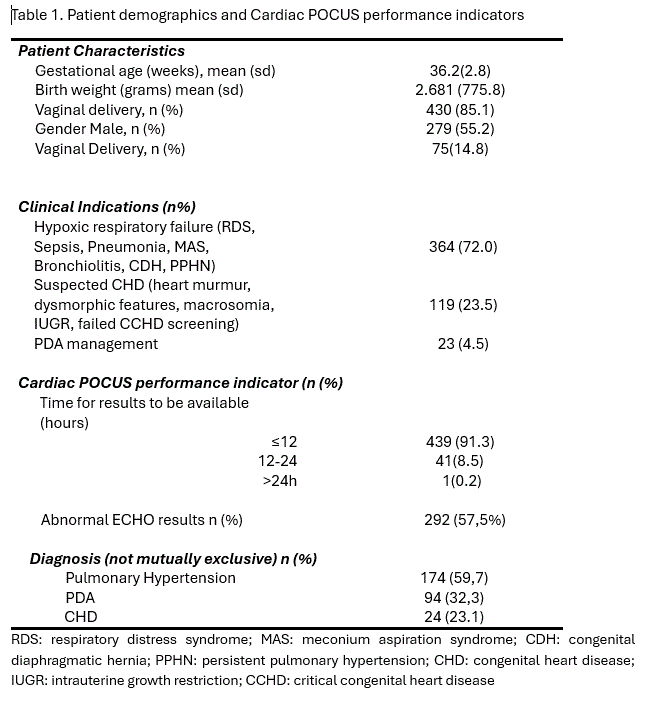Global Neonatal & Children's Health 1
Session: Global Neonatal & Children's Health 1
735 - Implementing Task Shifting Point-of Care Cardiac Ultrasound with Remote Diagnosis for Newborns in a Low Resource NICU in Colombia
Friday, April 25, 2025
5:30pm - 7:45pm HST
Publication Number: 735.5559
Adolfo R. Llanos, Nicklaus Children's Hospital, Key Biscayne, FL, United States; Silvia Aguilera Acevedo, Hospital Universidad del Norte, Barranquilla, Atlantico, Colombia; Juan S. Pimienta Parra, Universidad del norte, Barranquilla, Atlantico, Colombia; Maria A Ortiz Aguilera, MACSA, Bogotá, Distrito Capital de Bogota, Colombia; María Elena. Venegas Martínez, Universidad Del Norte, Barranquilla, Atlantico, Colombia; Jorge Luis Acosta-Reyes, Universidad de Antioquia, Barranquilla, Atlantico, Colombia; Hernando M. Baquero Latorre, Universidad Del Norte, Barranquilla, Atlantico, Colombia; Nesly Lorena Velandia Forero, Universidad del norte, Barranquolla, DC, United States
- AL
Adolfo R. Llanos, MD, MPH, FAAP (he/him/his)
Neonatologist
Nicklaus Children's Hospital
Key Biscayne, Florida, United States
Presenting Author(s)
Background: The World Health Organization (WHO) recommends task shifting point-of-care as one strategy to strengthen and expand the health work force. Task shifting point-of-care cardiac ultrasound (C-POCUS), using handheld echocardiography, has the potential to expand imaging capacity and impact patient management decision and outcomes at the primary care level in resource limited settings.
Objective: To evaluate the implementation of a C-POCUS for the diagnosis and management of cardiac disease in newborns delivered in a hospital located in Magangué, a small city in northern Colombia, a low-middle income country.
Design/Methods: We analyzed 508 C- POCUS conducted in 506 newborns during the period from October 1st, 2022, to September 30th, 2024. Data was collected prospectively. Images were obtained by trained nurses (n= 4) and pediatricians (n=4) working in the NICU. Images were obtained using Philips Affinity 50 Cardiac Ultrasound and transmitted for interpretation to a pediatric cardiologist and 2 neonatologists working at higher-level centers distant from Magangué. Transmittal of information was done via WhatsApp Messenger. The effectiveness of the intervention was evaluated by assessing the time in hours to have results available for the treating medical team and reporting abnormal findings to expedite clinical decision-making
Results: Patient demographics and program performance are presented in Table 1. Results were available within 12 hours for 439 (91.3%) of the procedures. Abnormal results were reported in 292 (57.5%) of the readings, with main diagnosis of pulmonary hypertension 174 (59.7%) followed by patent ductus arteriosus (PDA) in 94 (32,3%) readings, and congenital heart disease (CHD) in 24 (8,2%) readings. Twelve of these CHD patients, were referred to higher level NICU
Conclusion(s): Our experience supports the implementation of task shifting C-POCUS with remote diagnosis in NICUs located in resource limited settings. The C-POCUS implementation improved timely diagnosis of cardiac conditions expediting clinical decision-making in this low resource NICU setting.
Table 1. Patient demographics and Cardiac POCUS performance indicators
 RDS: respiratory distress syndrome; MAS: meconium aspiration syndrome; CDH: congenital diaphragmatic hernia; PPHN: persistent pulmonary hypertension; CHD: congenital heart disease; IUGR: intrauterine growth restriction; CCHD: critical congenital heart disease
RDS: respiratory distress syndrome; MAS: meconium aspiration syndrome; CDH: congenital diaphragmatic hernia; PPHN: persistent pulmonary hypertension; CHD: congenital heart disease; IUGR: intrauterine growth restriction; CCHD: critical congenital heart disease
